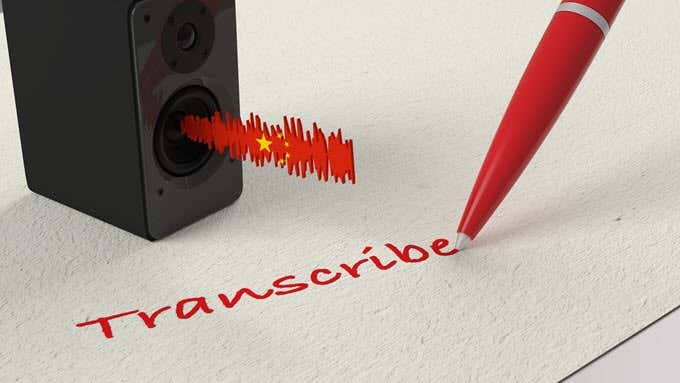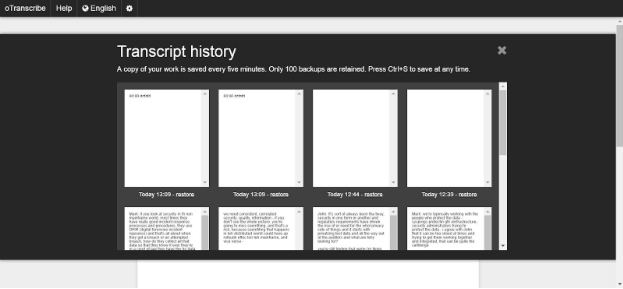As the digital age progresses, content creation continues to be vitally important. In particular, video production continues to grow in importance– both for individuals striving to rise as influencers in a world that revolves around social media and for the 63% of businesses now leveraging video and, of that slice, the 82% finding it to be an important part of their strategy. Meanwhile, podcasting is booming and expected to continue.
But simply producing this audio and/or visual content isn’t enough. The job of content marketing extends to helping people find what you create.
Beyond leveraging social media, this is where SEO (search engine optimization) plays an important role, i.e. serving up keywords and using other best practices that help search engines like Google discover your content.

Why Transcription Matters
A good transcription tool can make a major difference in boosting SEO and your overall volume of content. By leveraging one that either automates the transcription process or provides an advanced platform on which you can manually transcribe audio, you can instantly increase your web presence with more rich content – in this case, content that is directly related to the audio or video content you want people to discover – with little effort.
Of course, there could be other reasons for which you use a transcription tool, such as transcribing recorded conversations you’ve had for the purpose of writing articles with accurate quotes and storylines.
Or, perhaps you’ve recorded conversations with loved ones who have since passed and want to preserve those moments in a format you and others can go back to and read.

Regardless of your reasoning for producing audio-based content, transcribing it can be a smart move. If that sounds like something worthwhile to you, there is a plethora of available transcription tools ranging from free to subscription-based for you to choose from.
Here are three that offer unique advantages and, therefore, are worth investigating right away
Amazon Transcribe
Type: Automatic Transcription
User: Businesses; Developers; Marketers
Cost: Pay-as-you-go
While Amazon continues to expand its presence across industries, its subsidiary Amazon Web Services (AWS) continues to expand its breadth and depth of on-demand cloud computing platforms, offering around 120 unique and advanced solutions ranging from developer tools to analytics to automatic transcription and more. Here’s what makes Amazon Transcribe so worthwhile.

ASR for App Developers
Upon first thought, you may wonder why a company that provides tools to developers would offer an automatic speech recognition (ASR) service like Amazon Transcribe. It makes a lot of sense when you consider the importance of building smart applications in our digital age.
AWS Transcribe enables developers to build speech-to-text capability into their applications. Where this could come in handy for a business is in transcribing calls with customers or generating subtitles for audio and video, Amazon says.
Again, this would also come in handy for marketers who are trying to increase rich content volume and need a way to take existing audio content and transform it into text, which can then be used to create keyword-rich blog posts, articles, etc.
Automate Everything
It’s one thing to automate a general process but still leave bits and pieces for the user to manage after the fact. AWS’s goal for Amazon Transcribe is to leave as little work as possible for the user with a slew of advanced features, including, but not limited to:
- Edited Transcriptions: Rather than giving you a dump of text, Amazon Transcribe leverages machine learning to understand where punctuation is necessary and to format the text output so that it’s easy to ready and requires little to no editing.
- Timestamps: The transcription tool includes a timestamp for each word, making it possible to identify audio in your original recording simply by searching the text.
- Custom Vocabulary: You have the ability to broaden and customize the vocabulary AWS Transcribe recognizes to ensure specific words aren’t misinterpreted. This helps the transcription tool be incredibly accurate.
- Multiple-Speaker Recognition: If your audio includes multiple speakers, Amazon Transcribe can recognize when a new person is speaking and apply this understanding to its transcription, helping save you time in properly identifying speakers when you go to edit.
- Real-Time Transcription: You don’t have to wait to have a recording to transcribe with this transcription tool. If you’re live streaming audio, you can send it with a secure connection over the HTTP 2 protocol to Amazon Transcribe and get back a real-time stream of transcribed audio.
It’s an advance transcription tool that could require deep technical knowledge to take advantage of every feature and function available, but Amazon Transcribe is simultaneously simple enough for anyone to leverage for increased productivity. Here’s a video that goes into more detail:
There are other comparable transcription tools to Amazon Transcribe (Google Speech, Temi, IBM Watson, et. al.), but the fact is, AWS already provides a vast range of services and tools that most businesses are already taking advantage of on a pay-as-you-go basis, and you get access to all of them with one AWS account–including Amazon Transcribe.
Therefore, it’s likely to become the standout tool for businesses, developers and marketers.
The Truth: What Users Say
“Amazon Transcribe is fantastic and fast but its not perfect, you or someone else should go back and double check the text to the audio. Annoying, yes, but way less so than having to type it all up manually … if you are also a clever coder this could be a really neat and time saving process to look in to. But if you are just a simple video dude like myself, this process can still work for you.”
oTranscribe
Type: Manual Transcription
User: Journalists; Marketers; Nonprofessionals
Cost: Free
Just because you can automate something doesn’t mean you always should. At times, this is the case with transcription.
While there are advanced automated transcription tools like Amazon Transcribe save you time and energy, sometimes it’s smarter to use a browser-based, open source, manual transcription tool like oTranscribe.

Get Personal
The benefits of manual transcription tool are many, from improved accuracy of word recognition to better discernment of speakers and audio overlap. Not only that, but manually transcribing audio enables a person to become much more familiar with the content.
This can come in handy if, for instance, you’re a journalist transcribing a recorded interview and need to understand a deep level what it is you’re writing about and how your subject’s insight, or lack thereof, will contribute to the story.
Control Playback Speed
Of course, the biggest challenge to manual transcription is keeping pace with the audio track as you type it out while also maintaining accuracy with regard to words and sentences as well as the actual structure of the conversation.
For example, understanding when dialogue belongs together in one paragraph or when the subject matter of the conversation shifts and requires a new section. All of this plays into the efficiency with which you can read and edit the transcript later.
An important feature of oTranscribe is its audio speed adjuster, either by clicking and dragging or using the transcription tool’s indicated function keys, you can move the adjuster’s toggle left to slow down or right to speed up the audio.
This flexibility makes it easier to keep pace with audio as you transcribe, but it also makes it possible to achieve more clarity in cases where words or phrases may come through better at a slower or faster speed.

Transcription + Editing + Storage
A great benefit of oTranscription is that you can do everything within the app, never having to leave until you’re ready to export your results. Once you upload your audio and set the playback speed, you can start leveraging other standard text-editor functions to enhance the quality of your transcription right away.
From bolding and italicizing text to including timestamps to seeing how many words your transcript currently is, oTranscribe gives you the basics you need in a transcription tool.
As you’re transcribing, oTranscribe automatically saves your work to your browser’s storage every second. It also provides a transcript history where you can view previous versions that are saved every five minutes, with the transcription tool saving up to 100 of these at all times.

When you’re ready to export, you can download the file as markdown, text or an oTranscribe file, or you can upload it as a file to Google Drive, making the transition from the transcription tool to another platform fairly seamless.
The Truth: What Users Say
“I use oTranscribe. I leave out ‘ums’ and fix any syntax errors that won’t make sense when being read.”
“+1 for oTranscribe, that service is gold.”
Choosing a Tool
When transcribing a podcast episode, it would make sense to use a transcription tool that automates the process. But when it comes to writing an article, where you’re piecing together a story and looking for standout quotes, you might benefit more from manually transcribing the audio.
As for which tools you use to accomplish those tasks, personal preference, technical aptitude and cost are probably the biggest factors.
